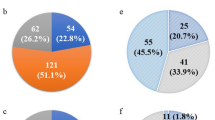Abstract
Purpose
To investigate the career pathways of board-certified surgeons’ and the factors associated with them maintaining their certification in Japan.
Methods
We analyzed data from the surveys of physicians, dentists and pharmacists. A multivariate logistic regression model was used to investigate whether factors such as gender, year of registration, place of work, and subspecialty board certification were associated with maintaining board certification.
Results
Most Japanese surgeons attain board certification within 5–10 years of initial medical registration. After adjusting for possible confounding factors, the odds of maintaining board certification were significantly lower for women, those who were beyond 20 years post-registration, those who worked in hospitals other than academic hospitals or clinics, and those who had board certification in surgery only. Of the total board-certified surgeons analyzed, 93.2 % continued to work in hospitals and 2.8 % moved to clinics within 2 years. Of those who moved from hospitals to clinics, half continued to practice surgery, while nearly 40 % changed their specialty to internal medicine.
Conclusion
It is necessary to establish a special training system for mature surgeons who move from surgery to general practice later in their careers. As the number of female surgeon increases, a support system is also required to secure the future supply of surgeons.



Similar content being viewed by others
References
Ministry of Health, Labour and Welfare. Panel on the future of Medical Specialties. Final Report of the panel on the future of Medical Specialties (in Japanese) http://www.mhlw.go.jp/stf/shingi/2r985200000300ju-att/2r985200000300lb.pdf. Accessed 27 Feb 2015.
Holden WD, Levit EJ. Migration of physicians from one specialty to another: a longitudinal study of US medical school graduates. JAMA. 1978;239(3):205–9.
Tardiff K, Cella D, Seiferth C, Perry S. Selection and change of specialties by medical school graduates. Acad Med. 1986;61(10):790–6.
Jennett PA, Kishinevsky M, Bryant H, Hunter KL. Major changes in medical careers following medical school graduation: when, how often, and why. Acad Med. 1990;65(1):48–9.
Bertram DA. Specialty changes made by young physicians from graduate training to practice. Med Care. 1993;31(6):533–41.
Koike S, Matsumoto S, Kodama T, Ide H, Yasunaga H, Imamura T. Specialty choice and physicians’ career paths in Japan: an analysis of National Physician Survey data from 1996 to 2006. Health Policy. 2010;98(2–3):236–44.
Mizuno Y, Narimatsu H, Kodama Y, Matsumura T, Kami M. Mid-career changes in the occupation or specialty among general surgeons, from youth to middle age, have accelerated the shortage of general surgeons in Japan. Surg Today. 2014;44(4):601–6.
Miyata H, Gotoh M, Hashimoto H, Motomura N, Murakami A, Tomotaki A, Hirahara N, Ono M, Ko C, Iwanaka T. Challenges and prospects of a clinical database linked to the board certification system. Surg Today. 2014;44(11):1991–9.
Ministry of Health, Labour and Welfare. Survey of Physicians, Dentists and Pharmacists 2012 http://www.mhlw.go.jp/toukei/saikin/hw/ishi/12. Accessed 27 Feb 2015.
Matsuda H. Where does the new regime of medical specialty certification go? Gen Thorac Cardiovasc Surg. 2013;61(10):547–50.
Otaki J. Considering primary care in Japan. Acad Med. 1998;73:662–8.
Starfield B, Shi L. Policy relevant determinants of health: an international perspective. Health Policy. 2002;60(3):201–18.
Koike S, Matsumoto S, Kodama T, Ide H, Yasunaga H, Imamura T. Estimation of physician supply by specialty and the distribution impact of increasing female physicians in Japan. BMC Health Serv Res. 2009;9:180.
Okoshi K, Nomura K, Fukami K, Tomizawa Y, Kobayashi K, Kinoshita K, Sakai Y. Gender inequality in career advancement for females in Japanese academic surgery. Tohoku J Exp Med. 2014;234:221–7.
Tomizawa Y. Women in surgery: little change in gender equality in Japanese medical societies over the past 3 years. Surg Today. 2013;43:1202–5.
Kaneto C, Toyokawa S, Inoue K, Kobayashi Y. Gender difference in physician workforce participation in Japan. Health Policy. 2009;89(1):115–23.
Kodama T, Koike S, Matsumoto S, Ide H, Yasunaga H, Imamura T. The working status of Japanese female physicians by area of practice: cohort analysis of taking leave, returning to work, and changing specialties from 1984 to 2004. Health Policy. 2012;105(2–3):214–20.
Acknowledgments
This study was supported by Health Labour Sciences Research Grant of the Ministry of Health, Labour and Welfare, Tokyo, Japan (H26 - Research on Statistics and Information - 001).
Author information
Authors and Affiliations
Corresponding author
Ethics declarations
Conflict of interest
Department of Health Management and Policy, Graduate School of Medicine, The University of Tokyo, where Soichi Koike is based, is an endowed department. It received funds from Nissay Information Technology Co., Ltd., Chugai Pharmaceutical Co., Ltd., Shionogi & Co., Ltd., Asahi Kasei Pharma Corporation, CRECON Research & Consulting Inc., and Otsuka Pharmaceutical Co., Ltd. The other co-authors have no conflicts of interest.
Rights and permissions
About this article
Cite this article
Koike, S., Shimizu, A., Matsumoto, M. et al. Career pathways of board-certified surgeons in Japan. Surg Today 46, 661–667 (2016). https://doi.org/10.1007/s00595-015-1212-5
Received:
Accepted:
Published:
Issue Date:
DOI: https://doi.org/10.1007/s00595-015-1212-5




